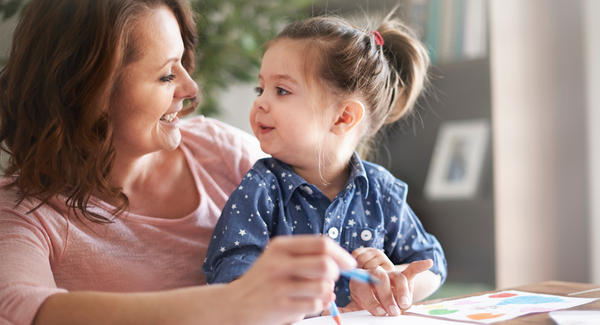If you have a little one with hearing loss and are using spoken language, you may have heard of the “Ling Six sounds” and wondered what they are. Or maybe you know what they are, but you’re struggling with how to actually use them with your baby. Read below for more information about why we use the Ling Six sounds and ideas about how to make them fun and enjoyable for both you and your little one! Note: this blog post is geared towards parents of young babies (ideally 0-18 months).
1. What are the Ling Six sounds and why do they matter? The Ling Six sounds, named for Daniel Ling, range across the span of pitches that we need to be able to hear in order to access spoken language. The idea behind using these six sounds is that if children can hear and understand these sounds, they have full access to the speech range. The Ling Six sounds are as follows: “ah, oo, ee, mm, ss, sh” and they range from low pitch to high pitch. One thing I want to mention is that while the Ling Six sounds are important, what matters most is that they are paired with language so that they become meaningful. (More to follow on that.) For families who are focusing on spoken language or total communication, we use the Ling Six sounds as a way to ensure that you and your child are able to communicate with one another.
2. What toys do I use with the Ling Six sounds? I suggest making a “Ling Box” where you will keep six toys that are associated with each of the Ling Six sounds. Within the field of listening and spoken language (or “auditory verbal therapy”), there are variations in what toys are used for these sounds. For example, some people may use a toy mouse for the “ee” sound, while others may use a toy car. It does not matter what toys you use, as long as you keep them consistent. Here is a list of common pairings:
AH: airplane
OO: ghost, train
EE: mouse, car, bumblebee
MM: ice cream, baby bottle
SS: snake
SH: baby
3. How do I make the Ling Six sounds meaningful for my child? Once you have your “Ling Box” ready, position yourself so that you are nice and close to your child and make one of the sounds out loud at a conversational volume. Be sure to do this while keeping the box closed and the toys out of your child’s line of vision. If your child turns her head, offer praise (“Yes, you heard “AH!”) and then quickly take the airplane out, show it to her and say, “You heard the airplane!” Play with the airplane together. Make it fly while saying “ahhhh!” Have the airplane go “up-up-up” and “dooooown.” Move the airplane through the air while saying “ahh,” then freeze and give your child an expectant look. Once she makes a sound with her voice, move the airplane through the air again. These are just a few of the many ways you can make this activity fun and meaningful for your baby. Just remember to use a lot of language, while also pausing to give your child a chance to “talk.”
4. The Ling Six sounds don’t have to be a formal, structured activity. Try sneaking them into different aspects of your daily routines. Is your child waiting in his high chair while you prep a meal? Quickly make one of the sounds, check for a response, and then give him the associated toy to play with while you cook. Changing your baby’s diaper? Make the “ah” sound, wait for her to look at you, and then make an airplane with your hand and have it “fly.” This helps to keep the activity new and interesting for your child while also helping him to generalize his listening skills to new environments.
5. Don’t overdo it. Like anything, use the Ling Six sounds in moderation. Don’t expect your young baby to be able to sit through a 30-minute activity using these sounds and toys. Follow your child’s lead and try to end the activity before it becomes boring or a power struggle. Short, frequent bursts are better than one long session a day. If you only get through one sound/toy before your child loses interest, don’t sweat it! Put the box away and when you come back to it later, start with one of the other sounds/toys. Slowly build up to longer periods of time. Before you know it, you and your child will be pros!





